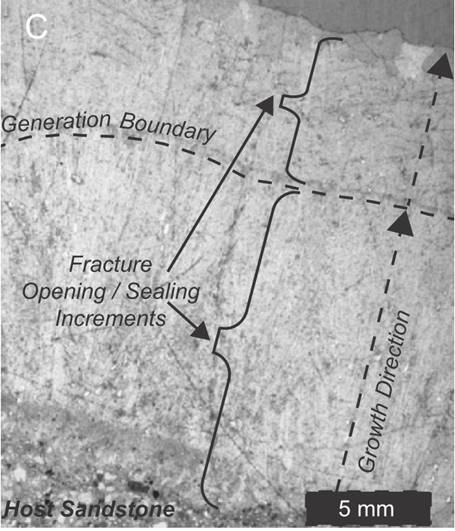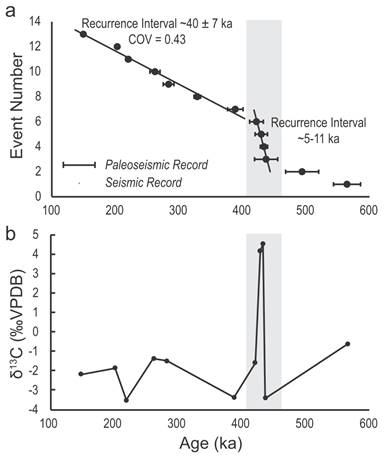Reports: ND855807-ND8: Rates of Calcite Cementation, Style of Deformation, and Timing of Flow through the Loma Blanca Fault Zone, Socorro Basin, NM
Laurel B. Goodwin, PhD, University of Wisconsin (Madison)
Peter Mozley, PhD, New Mexico Institute of Mining and Technology
Our research is guided by the concept that diagenetic cements are a fossil record of fluid flux that should allow us to track preferential flow pathways through extensional basins in both space and time. To realize the promise of this concept, we have integrated standard approaches to understanding the role of diagenesis in sandstone lithification as well as fault histories with novel strategies to evaluate fluid source and quantify the timing of cement precipitation. Our work has focused on the Loma Blanca normal fault, located ~5 km from the master fault bounding the western margin of the Soccoro Basin of the Rio Grande rift, NM. Significant results are detailed below.
Syntectonic Calcite Cementation Changes Fault-zone Architecture and Permeability Structure
Within the study area, the Loma Blanca fault juxtaposes variably lithified sands that range from lower Pliocene to Quaternary in age (Fig. 1a). Lithification was accomplished through calcite cementation, which was structurally controlled. Specifically, hanging wall sands are preferentially cemented with respect to both the remainder of the fault zone and undeformed sediment through much of this area, recording preferential hanging-wall fluid flux (Fig. 1b). Cemented zones, now sandstone, are resistant to weathering, and extend up to 10 m from the fault core.
Observations from the outcrop to the thin-section scale indicate that pre-cementation deformation was accomplished through different mechanisms than post-cementation deformation in the Loma Blanca hanging wall damage zone. Microstructural analysis demonstrates that deformation prior to fault-zone cementation was accomplished in broad zones by distributed particulate flow. Without pore-filling cements to ‘glue’ sand grains together, sliding and rotation of grains accommodated fault motion, producing a slip-parallel grain alignment. Post-cementation, the mechanically stronger sandstone responded differently to faulting, producing opening-mode fractures. These fractures were localized in the vicinity of relay zones, where fault segments overlap. Later calcite cement filled the fractures, hereafter referred to as veins. The apertures recorded by these veins decrease systematically with increasing distance from the relay zones (Fig. 2), indicating that fracture-enhanced permeability was greatest in the relay zones before cementation sealed the fractures. The abundance of calcite veins in the relay zones indicates that these sections of the fault served as pronounced fluid flow conduits prior to sealing. Moreover, microstructural analysis of individual veins indicates repeated episodes of fracturing and sealing by calcite (Fig. 3), suggesting that relay-zone permeability was episodically enhanced. Thus, syntectonic calcite cementation of the Loma Blanca fault resulted in a shift in both the location and magnitude of fault-zone fluid flow (Fig. 4).
Episodic Vein Opening Records Earthquakes, but Recurrence Interval Reflects Fluid Pressure
We have quantified the frequency and duration of fluid migration events in the vicinity of relay zones of the Loma Blanca fault through U-Th dating of vein calcite. Our sampling methodology exploits the microstructural record of sequential fracture opening and cement infilling (Fig. 4). Our results reveal a protracted history of fault-slip and fluid-migration events, with a mean recurrence interval of approximately 40,000 years (40 ± 6 ka; Fig. 5a). The highly periodic nature of these events is consistent with a “time-dependent” model of earthquake recurrence; i.e., it supports the hypothesis that a consistent period of time is required for stress to build to the level required for seismic failure. Additionally, the exceptional resolution of our geochronologic data allows us to identify a distinct cluster of fault-slip events centered on ~430 ka, during which period recurrence intervals were much shorter. Stable isotope analyses of veins associated with this cluster of seismic events record degassing of CO2 from migrating fluids (Fig. 5b), suggesting that the periodicity of fault slip and fracture formation could decrease with increasing fluid pressure, with fracture opening producing a pressure drop that facilitates degassing. Fracture sealing times estimated from three of the largest calcite veins indicate that fractures close in ~20 ka, defining the approximate duration of post-slip fluid migration. These data provide unique insight into the time scales of fault slip, fluid migration, and sealing events associated with syntectonic normal faults and the processes that govern them. When linked with basin and hydrocarbon generation histories, we expect these data to inform resource assessment in extensional systems.
Impact of the Work
This ACS PRF ND grant has supported the PI’s first effort to link the timing and flow paths recorded by fault-zone cement to changing fault-zone mechanics. It also has allowed us to establish several new collaborations, is currently funding the development of a new chemical tool to characterize fluid source, and has permitted our group to provide the first quantitative constraints on the timing and duration of ancient fluid flux through a fault. A graduate student supported by this grant received his PhD at the end of year one, and is now supported by the project as a post-doctoral fellow. PRF funding has allowed him to work at the unusual interface between geochemistry and structural geology, which significantly broadens his potential career options and pathways. One paper documenting PRF-funded results, on which he is first author, has been accepted with minor revisions. A second will be submitted soon.
Figure 1: a) Map showing location of Loma Blanca fault zone (LBFZ) in Socorro Basin. Box shows map area. b) Solid lines show cemented portions of LBFZ. Veins dated come from relay at South Fracture Zone.
Figure 2: Fracture aperture versus distance along strike from south to north within the South Fracture Zone.
Figure 3: Plane light photomicrograph of composite calcite vein recording two distinct generations of cement, indicating repeated episodes of fracture opening and sealing.
Figure 4: Conceptual model illustrating effect of syntectonic diagenesis on the locus, mechanism, and magnitude of fault-zone fluid flow during fault history. HW = hanging wall; FW = footwall. Open arrows in block diagrams schematically illustrate fluid migration through the damage zone (DZ) before (pre-lithification) and after (post-lithification) initial cementation.
Figure 5: a) U-Th dates on calcite veins record periodic seismicity and fluid flow. 2σ error bars are not shown where uncertainty is less than symbol size. b) Vein carbon isotope values as a function of time.
















